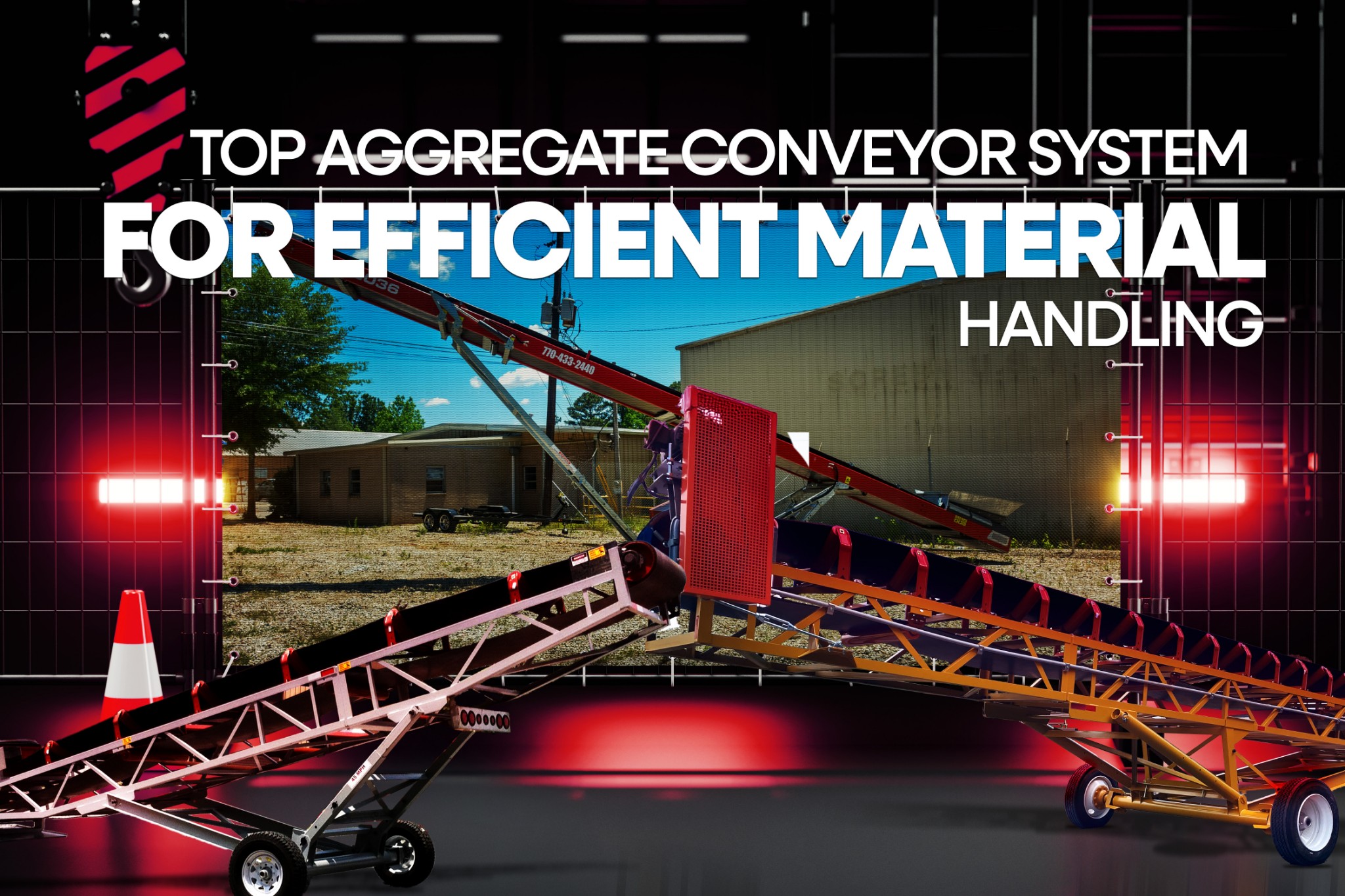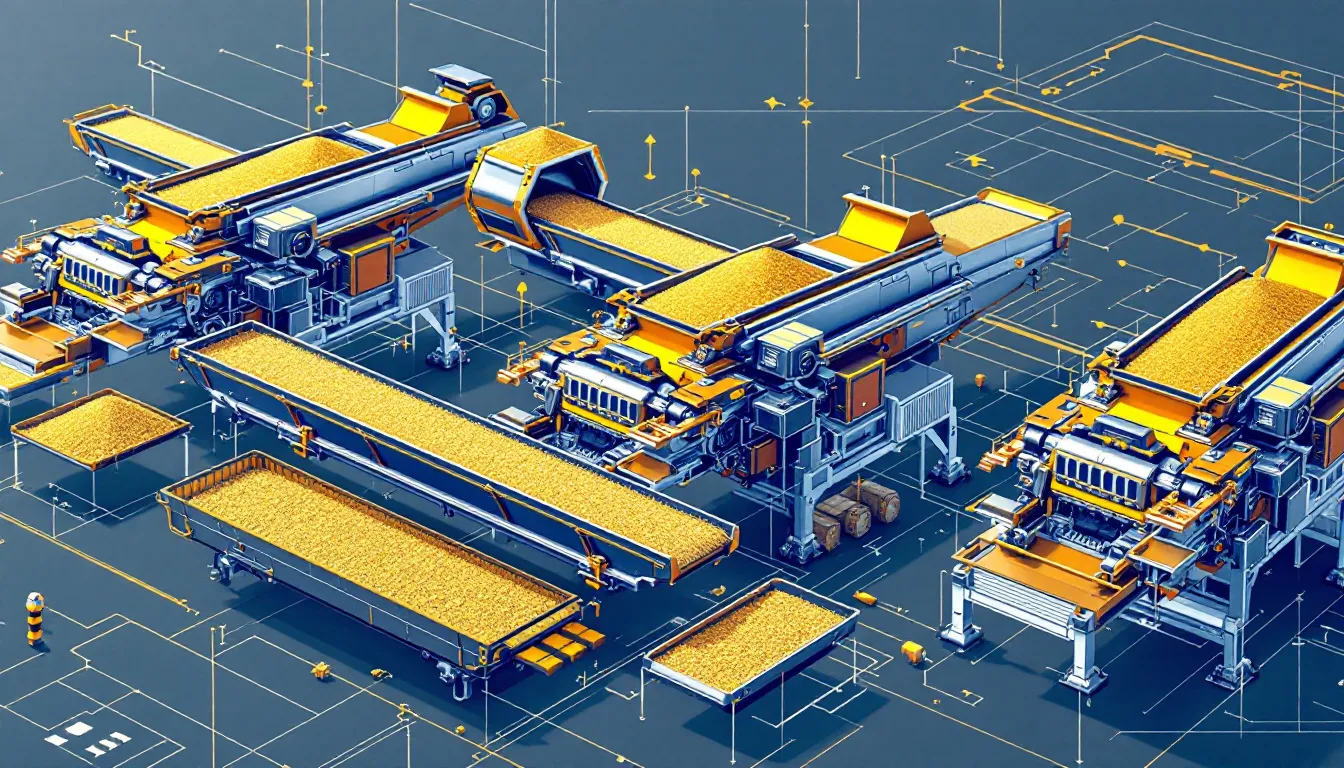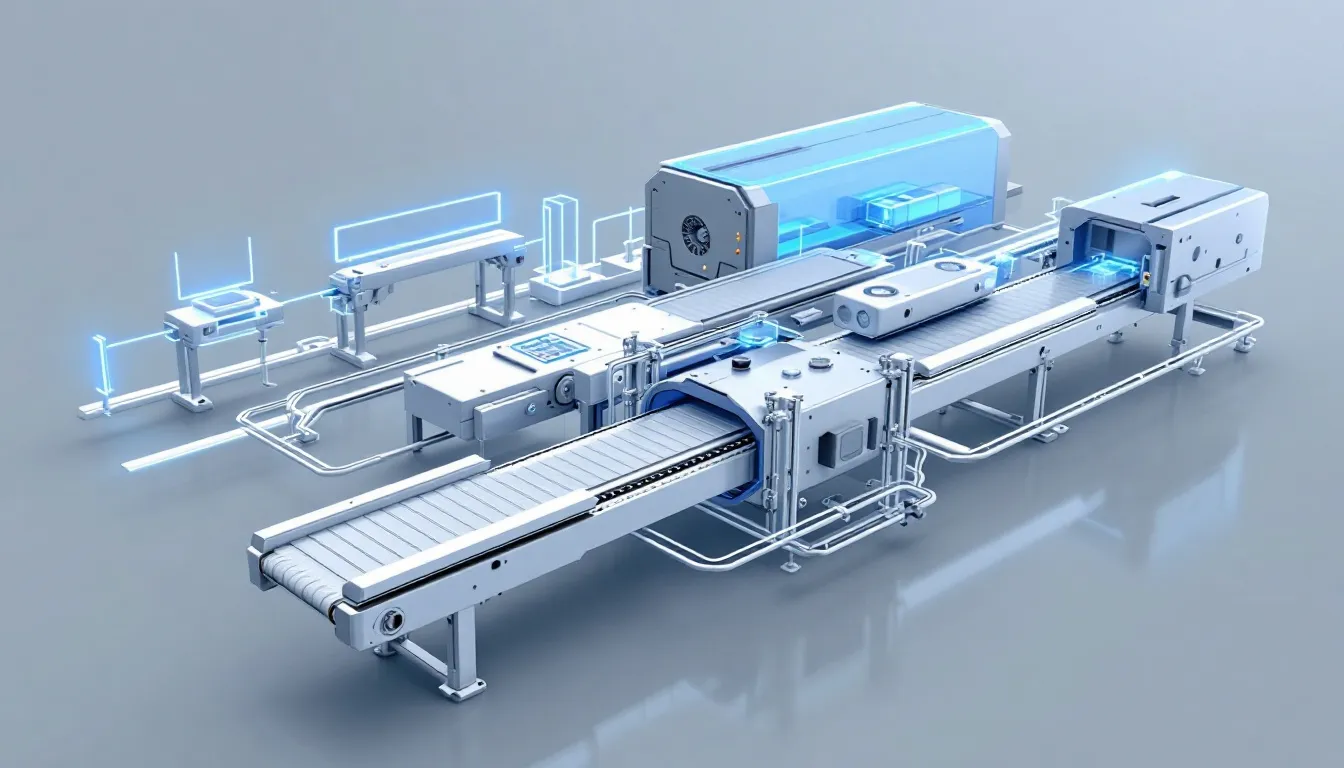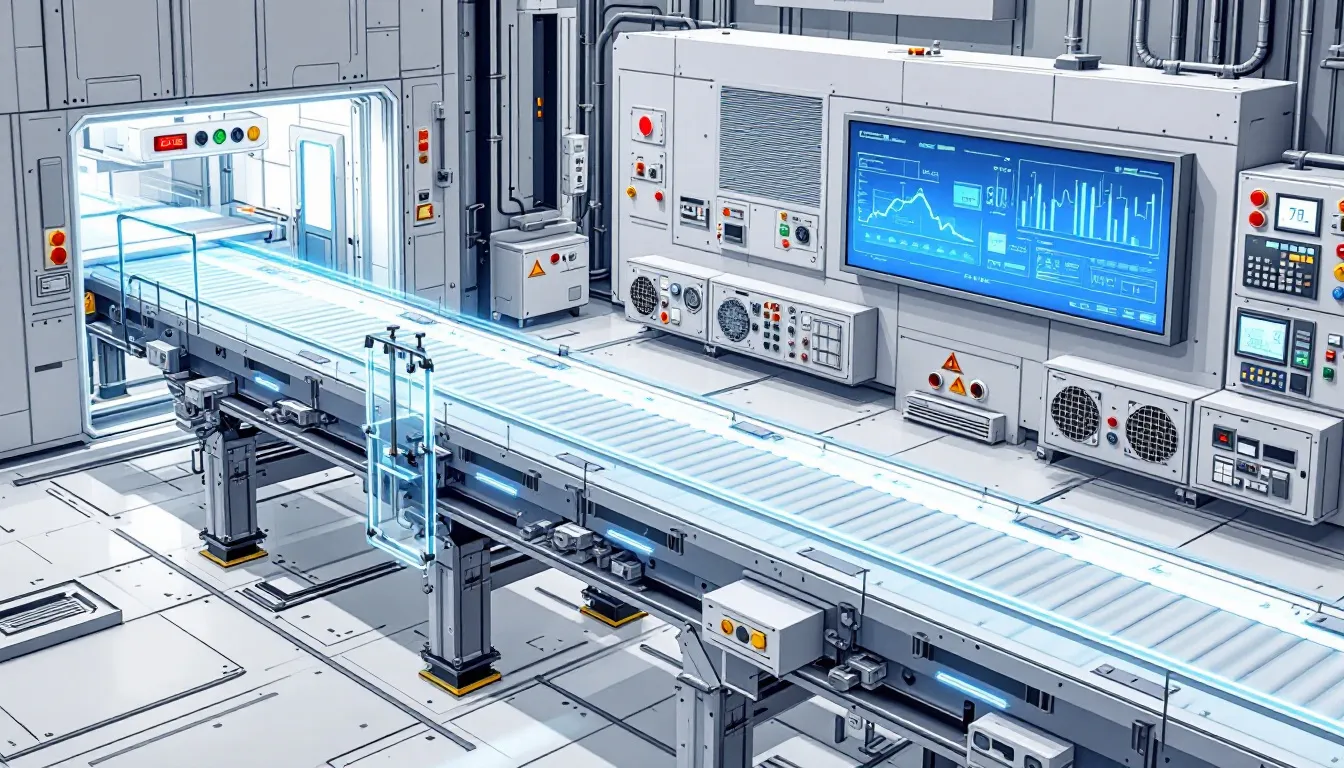An aggregate conveyor moves various types of aggregates such as gravel, sand, and recycled concrete efficiently across job sites. These systems reduce labor, boost productivity, and lower costs for industries like mining and construction. This article covers various types, applications, and benefits of aggregate conveyors.
Key Takeaways
- Aggregate conveyor systems are essential for efficiently transporting bulk materials across various industries, offering significant cost savings and enhanced productivity through automation.
- Different types of aggregate conveyors, such as radial stackers, overland, and portable conveyors, can be tailored to meet specific customer's applications and provide distinct advantages in material handling.
- Regular maintenance and high-quality replacement parts are crucial for the longevity and efficiency of aggregate conveyor systems, alongside a strong focus on safety during their operation.
Introduction to Aggregate Conveyors
Aggregate conveyors are specialized equipment designed to transport aggregate materials, such as sand, gravel, and crushed stone, efficiently and safely. These conveyor systems play a crucial role in various industries, including construction, mining, and quarrying. With the ability to handle large volumes of material, aggregate conveyors help reduce labor costs, minimize dust and noise emissions, and increase productivity. By using aggregate conveyors, companies can save money on fuel costs and reduce their environmental footprint. Whether it’s a custom-designed system or a standard model, aggregate conveyors are essential for transporting aggregate materials from one location to another.

Understanding Aggregate Conveyor Systems
Aggregate conveyor systems are crucial in efficiently transporting bulk materials like gravel and sand across job sites. They are designed to handle large volumes of material, ensuring that operations run smoothly and efficiently. These systems are an integral part of various industries, including quarrying, mining, and mineral processing, where the aggregate conveyor needs efficient movement of materials is paramount, including recycled concrete.
Quarries are essential sources of raw materials like sand and gravel, which are transported using aggregate conveyor systems.
The primary function of aggregate conveyors is to move materials from one location to another, whether it be from extraction sites to processing areas or from stockpiles to loading zones. Automating this process with aggregate conveyors cuts down on manual labor and heavy machinery usage, resulting in significant cost savings and increased productivity.
The different types of aggregate conveyor systems, their specific applications, and their benefits will be explored. From radial stackers to overland conveyors, each type has unique features that make it suitable for specific tasks in material handling.
Types of Aggregate Conveyors
Aggregate conveyors are classified into different categories such as overland, stacking, transfer, and loading/unloading types, each tailored for specific applications in material transport. Selecting the right system for your operational needs requires an understanding of the various aggregate conveyor types.
Aggregate conveyors come in various configurations, including stationary and portable models, to suit different operational needs.
Each type of conveyor has its unique advantages and is designed to handle specific tasks. For instance, radial stackers are ideal for heavy construction and bulk material handling, while portable conveyors offer flexibility for loading and unloading tasks across various industries.
Details of the different types of aggregate conveyors, starting with radial stackers, will be discussed next.
Radial Stackers
Radial stackers are a versatile and efficient solution for material handling. Their unique ability to pivot allows them to create large stockpiles of materials, enhancing storage efficiency on job sites. Radial stackers allow materials to be stored in an arc, increasing storage capacity and reducing material handling time. This feature is particularly useful in managing large volumes of aggregate material, such as sand and rock.
Radial stackers optimize space and ensure materials are readily available, reducing downtime and enhancing overall productivity. These conveyors are a valuable asset in heavy construction, remediation, and bulk material handling applications.
Overland Conveyors
Overland conveyors are designed to span long lengths, making them ideal for transporting materials from extraction sites to processing areas. With belt widths typically ranging from 30 to 84 inches, these overland conveyors can accommodate a variety of material types and volumes.
Overland conveyors are ideal for transporting raw materials from quarries to processing areas, ensuring a steady supply for various construction applications.
One of the significant advantages of overland conveyors is their capacity, which can reach up to 6,000 TPH. Overland conveyors reduce the need for trucks, thereby lowering transportation labor costs and minimizing fuel expenses. This not only makes them more economical but also environmentally friendly, as they reduce carbon emissions associated with truck transportation.
Transfer Conveyors
Transfer conveyors are particularly useful for handling materials that require elevation changes or need to connect different conveyor systems. They are designed to efficiently move materials from one point to another, ensuring a smooth transition between different stages of the material handling process.
Telescopic conveyors are also used in transfer operations, providing flexibility in length and efficient material handling.
These conveyors are essential in operations where materials need to be loaded and unloaded at various heights and locations. These conveyors enhance overall efficiency and reduce the need for additional handling equipment by facilitating seamless material transfer.
Portable Aggregate Conveyors
 Portable conveyors, also known as grasshopper conveyors, offer unmatched flexibility and convenience in material handling. Designed to be lightweight and easy to transport, these conveyors can carry a description of how they can be repositioned as needed for various tasks across different settings. Their ability to handle incline and decline operations makes them versatile tools for loading and unloading tasks in industries such as construction, mining, and landscaping.
Portable conveyors, also known as grasshopper conveyors, offer unmatched flexibility and convenience in material handling. Designed to be lightweight and easy to transport, these conveyors can carry a description of how they can be repositioned as needed for various tasks across different settings. Their ability to handle incline and decline operations makes them versatile tools for loading and unloading tasks in industries such as construction, mining, and landscaping.
Portable conveyors can be custom-built to meet the specific needs of customers, offering flexibility and efficiency in material handling.
Portable conveyors are an excellent solution for projects that require frequent changes in elevation and layout, especially when the terrain is inclined.
Conveyor System Components
A conveyor system consists of several key components, including the conveyor belt, pulleys, idlers, and drive systems. The conveyor belt is the most critical component, as it comes into direct contact with the aggregate material. Available in various belt widths and lengths, conveyor belts can be designed to handle specific aggregate conveyor needs. Radial stackers, for example, use a pivot stand beneath the loading hopper to enable easy setup and efficient material handling. Other components, such as rubber troughed belts and three-phase motors, contribute to the overall efficiency and reliability of the conveyor system. By selecting the right components, companies can ensure their conveyor system operates smoothly and safely.
Replacement Parts for Aggregate Conveyors
Maintaining the efficiency and longevity of aggregate conveyor systems requires high-quality replacement parts. Sourcing from reputable manufacturers like Metso ensures that parts meet strict standards for durability and performance. Conveyor belts, terminal equipment, and other components are essential for keeping aggregate conveyor systems running smoothly.
Brands like Falk, Voith, Rexnord, Dodge, and Depreaux offer a wide range of replacement parts designed to enhance conveyor equipment performance and longevity. Maintaining a supply of recommended spare parts allows operators to effectively manage inventory, reduce costs, and ensure critical components are available for preventive maintenance.
Custom Designed Conveyor Systems
 Custom-designed aggregate conveyor systems are tailored to meet specific operational needs, adding significant value to manufactured material handling processes. These systems can effectively resolve challenges such as dust management, handling abrasive materials, and influencing transfer rates.
Custom-designed aggregate conveyor systems are tailored to meet specific operational needs, adding significant value to manufactured material handling processes. These systems can effectively resolve challenges such as dust management, handling abrasive materials, and influencing transfer rates.
In a custom-designed aggregate conveyor system, the drive system, belt construction, structure, and dust control components are all optimized for enhanced performance. These systems address unique operational requirements, ensuring efficient and reliable material handling.
Material Handling Solutions
Conveyor systems offer cost-effective and efficient material handling solutions compared to traditional methods. Their higher energy efficiency compared to diesel-powered haul trucks results in significant operational cost reductions over time. Additionally, conveyors provide continuous operation without the downtime associated with trucks, enhancing overall productivity.
Over long distances, conveyor systems can deliver lower costs per ton of material moved than trucks, making them more economical for extensive projects of considerable length. They also have a lower environmental impact due to reduced carbon emissions from diesel engines, enhancing the overall delivery efficiency and saving tons of money.
A robust safety culture around conveyors is crucial to prevent accidents and ensure safe operations and reliability.
Aggregate Conveyor Installation and Maintenance
Proper installing and maintenance are critical for ensuring the efficiency and longevity of aggregate conveyor systems. Marking the center line with a chalk line during installation helps maintain alignment and ensures smooth product movement. Lagging conveyors to the floor not only ensures stability but also minimizes the risk of accidents when they are installed.
Regular maintenance, including keeping a variety of spare parts packages, helps reduce downtime and enhance operational efficiency. Maintaining conveyor reducers and gearbox components with the appropriate oil and adhering to load capacities prevent premature wear and damage, allowing you to save money.
Safety Considerations for Aggregate Conveyors
 Safety is paramount in conveyor operations. The automation of material handling through conveyors improves safety by lowering injury risks associated with manual labor. Educating employees about conveyor safety and using guards around conveyors are vital measures to prevent accidents.
Safety is paramount in conveyor operations. The automation of material handling through conveyors improves safety by lowering injury risks associated with manual labor. Educating employees about conveyor safety and using guards around conveyors are vital measures to prevent accidents.
Lock Out/Tag Out procedures and ensuring the proper functioning of emergency stop switches enhance safety during maintenance. Access to routine inspections, advanced cleaning systems, and dust management solutions contribute to safer working environments.
Cost Savings and Efficiency with Modern Conveyor Systems
Modern conveyor systems optimize material transport, reducing fuel costs and the number of trips required by trucks. Using barge transportation for aggregates can further reduce costs and enhance efficiency, especially for producers with access to coastal waterways. Minimizing manual handling with these systems reduces labor costs and accelerates project timelines, boosting overall efficiency with other materials in the production process.
Industry-Leading Manufacturers
Industry-leading manufacturers, such as West River Conveyors and Groundworx, offer a range of aggregate conveyor systems designed to meet specific customer needs. These manufacturers provide custom-designed conveyor systems, replacement parts, and expert installation services to ensure optimal performance and efficiency. With a focus on safety, reliability, and productivity, these manufacturers help companies in the aggregate industry transport materials efficiently and cost-effectively. By partnering with industry-leading manufacturers, companies can benefit from their expertise and experience in designing and installing aggregate conveyor systems that meet their unique requirements. Whether it’s a portable conveyor or a stationary model, these manufacturers can provide the right solution for aggregate material handling needs.
Summary
The summary will wrap up the key points discussed in the blog, reinforcing the importance of aggregate conveyor systems in modern material handling and their benefits in enhancing efficiency and reducing costs.
Frequently Asked Questions
What are aggregate conveyor systems?
Aggregate conveyor systems are essential for the efficient transportation of bulk materials such as gravel and sand at construction sites, minimizing reliance on manual labor and heavy machinery.
These systems can handle both dry and wet materials, making them versatile for various construction applications.
What types of aggregate conveyors are available?
Various types of aggregate conveyors are available, such as overland, stacking, transfer, and loading/unloading conveyors, each designed for distinct material transport applications. Selecting the appropriate type is crucial for efficient operations.
How do overland conveyors benefit material handling?
Overland conveyors enhance material handling by spanning long distances, which reduces reliance on trucks, lowers fuel and labor costs, and offers an economical and environmentally friendly solution.
Why are replacement parts important for aggregate conveyors?
Replacement parts are crucial for aggregate conveyors as they maintain efficiency and extend the system's lifespan, ultimately minimizing downtime and improving overall performance.
What safety measures are essential for conveyor operations?
Essential safety measures for conveyor operations include educating employees, utilizing guards, implementing Lock Out/Tag
Out procedures, and ensuring emergency stop switches are functioning properly. These practices are critical to maintaining a safe working environment.
